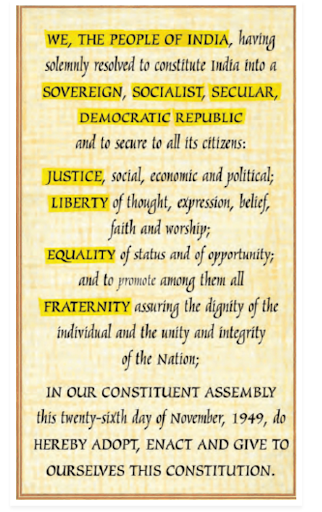Social Science Notes for Chapter 2 Constitutional Design Class 9 - FREE PDF Download
FAQs on Constitutional Design Class 9 Social Science Chapter 2 CBSE Notes - 2025-26
1. What is the best way to do a quick revision of Class 9 Civics Chapter 2 with these notes?
For a quick revision using the Constitutional Design Class 9 Notes, start by understanding the summary of South Africa's struggle against apartheid, as it sets the context. Then, focus on the key milestones in the making of the Indian Constitution and the main functions of the Constituent Assembly. Conclude by reviewing the guiding values outlined in the Preamble, such as Sovereign, Socialist, Secular, and Democratic Republic.
2. What key concepts should I focus on in the Constitutional Design summary for my exams?
When revising from the summary, focus on these core concepts:
The need for a Constitution: Why countries require a set of basic rules.
The Constituent Assembly: Its composition, key members, and the process of drafting the constitution.
Guiding Values: The philosophy behind the Indian Constitution, especially the terms in the Preamble like Justice, Liberty, Equality, and Fraternity.
Institutional Design: How the constitution provides a framework for the government's structure and function.
3. How do the revision notes explain the role of the Preamble in the Indian Constitution?
The revision notes explain the Preamble as the introduction or preface to the Indian Constitution, containing its core philosophy. It is described as the 'soul of the constitution' because it summarises the ideals and aspirations of the nation. These notes highlight how the Preamble acts as a guiding light for interpreting the Constitution's provisions and for making new laws. For a deeper understanding, you can refer to the NCERT Solutions for Constitutional Design.
4. What was the role of the Constituent Assembly as highlighted in the Class 9 notes?
The notes highlight that the Constituent Assembly was the body of elected representatives responsible for drafting the Indian Constitution. Its primary role was to deliberate on every clause and produce a document that reflected the diverse aspirations of the Indian people. The assembly worked for 2 years, 11 months, and 18 days to create a balanced and enduring constitutional framework for India.
5. Why do the revision notes for this chapter start with the example of South Africa?
The notes begin with South Africa's struggle against apartheid to provide a powerful real-world example of why a constitution is essential. It illustrates how a country, deeply divided by conflict, can come together to form a democratic government based on equality and justice by agreeing on a set of fundamental rules. This story effectively demonstrates the challenges and importance of constitutional design before delving into the Indian context.
6. How can these notes help me score better in the exam?
These revision notes help improve exam scores by providing a concise summary of the entire chapter, making it easier to remember crucial facts, dates, and names. They break down complex topics like the philosophy of the constitution into simple points. Using these notes for last-minute revision helps reinforce your understanding and ensures you can answer questions accurately and confidently. After revising, you can test your knowledge with Important Questions for Constitutional Design.
7. Since the Constituent Assembly wasn't elected by universal adult franchise, how do the notes explain its legitimacy?
The notes explain that although the Constituent Assembly was elected by members of the existing provincial legislatures, it held immense legitimacy for several reasons. Firstly, it included members from almost all regions and communities of India. Secondly, it represented a wide range of political opinions. Finally, the manner in which it worked—through systematic, open, and consensual debate—gave sanctity to its decisions, making the Constitution acceptable to all.
8. How do the guiding values in the Constitution, as summarised in the notes, ensure India remains a democracy?
The guiding values summarised in the notes, such as democracy, liberty, equality, and justice, are the bedrock of India's democratic system. The value of democracy ensures that the government is elected by the people. Liberty guarantees freedom of thought and expression. Equality prevents discrimination and ensures equal opportunities for all. These principles, embedded in the constitution, create a framework that prevents the rise of authoritarianism and protects the rights of citizens.
9. According to the revision summary, what fundamental function does a constitution perform for a society?
The revision summary highlights that a constitution's most fundamental function is to generate a degree of trust and coordination necessary for different kinds of people to live together. It specifies how the government will be constituted, who will have the power to make which decisions, and sets limits on the powers of the government. Most importantly, it lays down the rights of citizens, ensuring the government cannot violate them.





































